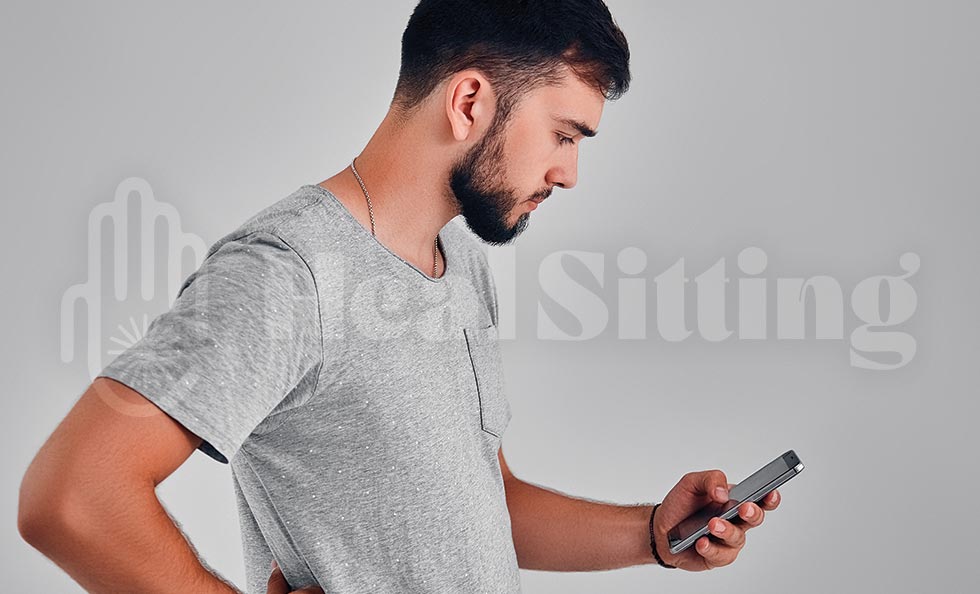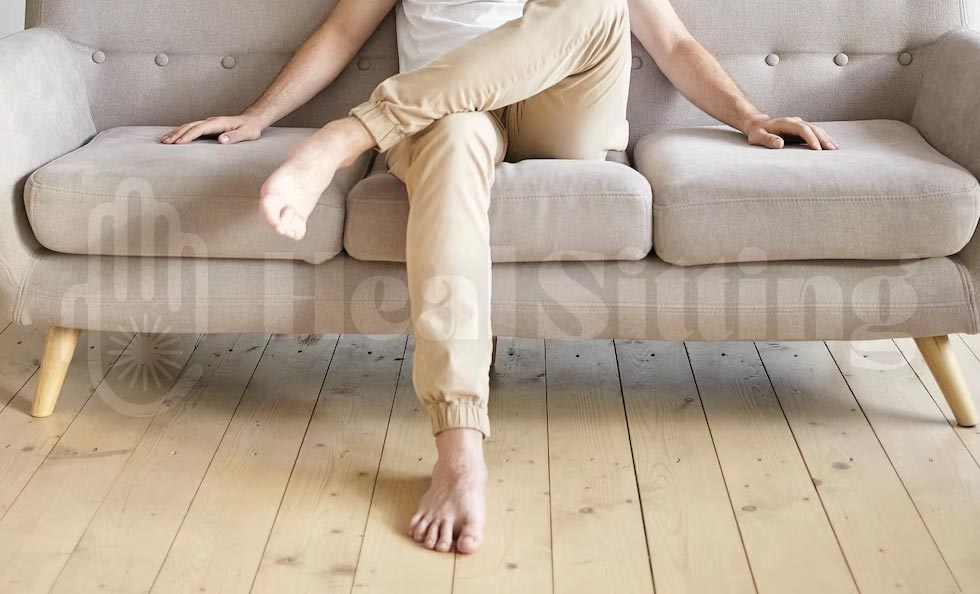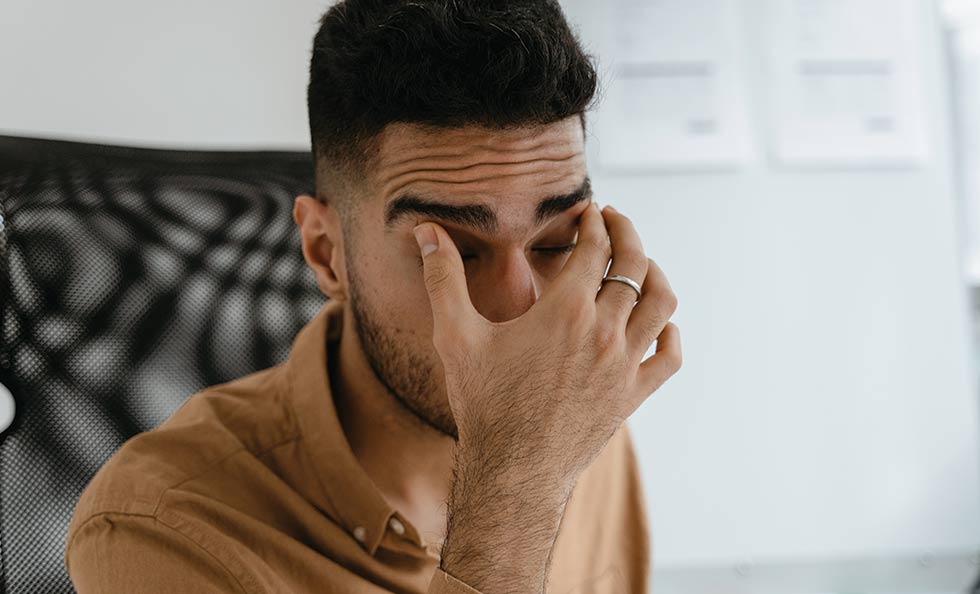This is an observation of mine in researching various body postures that lead to imbalances in the muscles and nervous system, hence experiencing pain and stiffness. It is this problem that appears to be the leading cause. Even if all our muscles are in balance, poor postures will still lead to back problems.
I will now look at a few such postures and what problems they cause.
The first bad posture is when we sit or stand with our heads bent down, look at our phones, or read a book
What happens? The muscles of the back that support the head in the correct position decrease their tone, and the deep muscles located around the vertebrae of the neck begin to overwork. This imbalance can remain after we return the head to its normal position. We tried an experiment: we put a person to take a bad position for only 3 minutes. We test how the muscles work before and after. We found that after the 3 minutes, some of the muscles changed tone and became weaker, while others became tenser. That is, after this 3-minute bad position, the muscles permanently impair their function, and pain and/or stiffness occur after a while or immediately. This is explained by a reflex of the body – when we bend the head forward, the body prepares for a front roll and reduces the tone of the back muscles so we can roll. However, if we stand for more than 3 minutes in this preparatory position, back problems will follow.
In order to deal with the consequences, it is necessary to perform three exercises from the Heal Sitting Gymnastics:
- We rub the points of the occiput with our fists.
- Stretch the neck muscles by turning the head sideways at 45 degrees and pulling it down with the hand on it while exhaling.
- Hands are behind the nape of the neck, we push the head towards them, with the chin tucked in, the hands counter for 3 seconds, then we relax for 3 seconds and repeat this 3 times.
The second bad posture is sitting cross-legged – leg over leg
This is one of the most common comfortable sitting and working positions for many people. Why are we comfortable sitting this way? The reason lies in the instability of the pelvis coming from the weak tone of the gluteal muscles. To stabilize the pelvis without the involvement of the gluteal muscles, we cross the legs.
The body is really perfect and can adapt even to bad positions. This is the case here. Sitting cross-legged for more than 3 minutes, it gets used to this position and is comfortable in it. However, the moment we cross or stand up, the tone of one half of the body decreases, and that of the other half increases. The whole spine twists and pain can occur in both the neck and lower back. To deal with this problem, an exercise from “Heal Sitting” is needed to balance the dura. And in order to get out of this habit, every time we take such a position, we should correct ourselves and do the hard cranial shell exercise.
The bad position is an aligned sitting posture with a flattened curve of the waist, a deepened curve in the chest, and a forward protrusion of the head.
This a common position for many people working at a computer all day. The damage we do to the back and body here is really extensive. Pain in the shoulders, shoulders, neck, waist, wrists, forearms, elbows, and fingers. We start with a blockage of the thoracic diaphragm and a reduction in breathing capacity. We continue by weakening the tone of the back muscles. Tension in the neck and neck. Tension in the chest and shoulder muscles. Tension in the forearms and wrists.
Almost the whole body goes out of balance because of this position. And what’s even worse here is that people sit and work this way for years, which is why they get spinal changes.
If we are willing, we can eliminate this position with self-monitoring and correction. We sit on the chair, bringing the pelvis as far back as possible towards the backrest, leaning back and the head naturally takes the correct position. We are careful not to bend the head down and not to bring it forward.
To deal with the consequences, we recommend the exercise to activate the thoracic diaphragm, the Fearful exercise, and the exercise to activate the abdominal muscles.
The third bad position is sitting on one ankle.
This bad position can cause knee and low back pain. Why? It twists the ankle and with it the bone that reaches the knee from the outside.
Very often when crossing the leg, stretching forward, and sitting on the ankle, the joint that catches just below the knee on the outside shifts slightly forward or backward. This can cause knee pain, change the gait and lead to low back pain as well.
This problem is very difficult to identify, so I am going to give you a technique to apply for knee pain, especially if you sit in this position often. You bend the knee and begin a slow circular motion at the ankle joint. You move in one direction for 10 reps, then in the other direction also for 10 reps.
The last bad posture I’m going to cover leads to neck and back pain.
It is when we are lying down and reading a book or watching TV. The head is propped up with a pillow and is bent forward. So the muscles supporting the head are switched off and the deep muscles of the neck come to the rescue. They become overloaded and the neck stiffens. Often the upper back also becomes ill afterward.
To deal with this problem, we first need to find another position: for example, semi-reclining, with the head more upright. In this way, we avoid disconnecting the head muscles and subsequent stiffness.
With already stiff muscles we can do the following exercises:
1. Rub the points of the occiput with our fists.
2. Stretch the neck muscles by turning the head sideways at 45 degrees and pulling it down with the hand on it while exhaling.
3. Hands are behind the nape of the neck, we push the head towards them, with the chin tucked in, the hands counteract for 3 seconds, then we relax for 3 seconds and repeat this 3 times.
Some people think that by training regularly or doing exercises, they will not suffer from pain and stiffness. However, they often face musculoskeletal problems. The main causes turn out to be habitual poor body positions as well as the jaw muscle. The stronger your muscles are, the greater the stiffness.
* Healsitting.com articles are for informational and educational purposes only and do not replace professional medical advice, diagnosis, or treatment. Always consult your doctor for any questions you may have about a medical condition.








